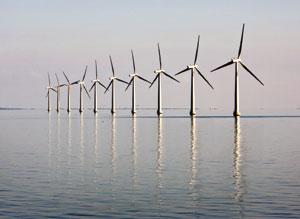Clean-energy investments target eastern Europe, but it remains to be seen whether they will create as many new jobs as hoped.
 Wind farms could benefit from greater investment by the European Commission.B. STRONG/REUTERS
Wind farms could benefit from greater investment by the European Commission.B. STRONG/REUTERSThree months after European Union (EU) leaders committed themselves to cutting greenhouse gases by at least 20% from 1990 levels by 2020, the European Commission has announced that it will subsidize 'green' programmes and infrastructures with €105 billion (US$136 billion).
The windfall comes from the union's €347 billion in 'structural' funds. It is the second-largest budget in the commission's portfolio, behind agriculture, and is aimed at creating equal standards of living across the EU.
Although no fresh money is involved — the size of the structural funds was agreed in 2007 — the amount allocated to green projects is nearly triple that of the previous budget period, from 2000 to 2006. Regions within the EU are free to decide how to spend the money, as long as they meet the general criteria and priorities set by the commission.
The money is necessary if Europe is to deliver on its high hopes for wind and other low-carbon energy sources, says Greg Arrowsmith, a policy officer with the European Renewable Energy Centers Agency in Brussels. Just €2.3 billion of the EU's €51-billion Seventh Framework Programme — Europe's main source of research funding — is earmarked for non-nuclear energy technologies.
The new investment will not cover carbon capture and storage projects, but it does address many others related to energy and climate. Around €9 billion is targeted for renewable energy and energy-efficiency projects, and an additional €29 billion will be invested in modernizing railways and in urban transport projects aimed at reducing emissions from cars. Significant funding will also be available for water and waste-management projects, biodiversity and nature conservation, and for encouraging the development of eco-friendly goods and services by small and medium-sized enterprises.
The commission hopes that the investment will create new jobs and help to revive regions that are suffering in the current economic downturn. "Support for the green economy and the environment goes hand-in-hand with the cohesion policy's objective to deliver sustainable growth, jobs and competitiveness," regional policy commissioner Danuta Hübner said when announcing the figures on 9 March.
The bulk of the money (€60 billion) will go to countries in eastern and southeastern Europe that lag behind the rest of the union, economically and environmentally. The largest beneficiaries will be Poland (€18 billion), Spain (€12 billion), the Czech Republic (€11 billion) and Hungary (€9 billion). Money from the regional funds could, for example, be used to convert old ports on Poland's Baltic coast into transit points for testing and installing off-shore wind turbines. It is, however, up to local politicians to decide exactly how to apportion the funds.
The plan exceeds the expectations of many economists and energy experts, who had hoped that the economic crisis would create an impetus for 'greening' the economy, as has happened with massive investments in countries such as the United States, Japan, South Korea and Germany.
“The massive public stimulus will give a lot of extra impetus to green investment.”
"This is the way to go," says Claudia Kemfert, an expert on climate, energy and transport at the German Institute for Economic Research in Berlin. "This kind of economic stimulus makes a lot more sense than bonuses to people who give up old cars to buy new vehicles." A €2,500 'car-scrapping' incentive, part of Germany's own €50-billion stimulus package, is boosting car sales, but has been criticized on economic and environmental grounds.
Oliver Schäfer, policy director at the Brussels-based European Renewable Energy Council, says that the EU's renewable-energy industry — involving some 350,000 jobs, and generating €40 billion a year in business volume — will benefit substantially from the boost in public funding. Experts have estimated that it will take around €600 billion to help the EU increase the amount of energy it obtains from renewable sources from the current 8.5% to its goal of 20% in 2020. Subsidies through the structural funds programme will provide start-up financing for new solar, hydro- and wind-power facilities, for wires needed to transport 'green' electricity to consumers, and for decentralized energy supplies such as through rooftop solar-energy collectors.
But promises of funding injections have hit stumbling blocks in the past. The commission's economic recovery plan, proposed last November, foresees €3.5 billion in unspent money from the past budget period being reallocated to investment in energy technologies, including €500 million for offshore wind projects and €1.5 million for carbon capture and sequestration. But several groups in the European Parliament, which will vote on the issue later this month, are seeking to stop the plan. Critics say that few of the envisaged projects will materialize soon enough to help economic recovery.
Regardless, the €105 billion from the structural funds will still flow. "Sustainable funds have had renewable energies and water projects on their radar for quite some time," says Rolf Häßler, an analyst with the rating agency Oekom Research in Munich, Germany. "The massive public stimulus will give a lot of extra impetus to green investment."




No comments:
Post a Comment